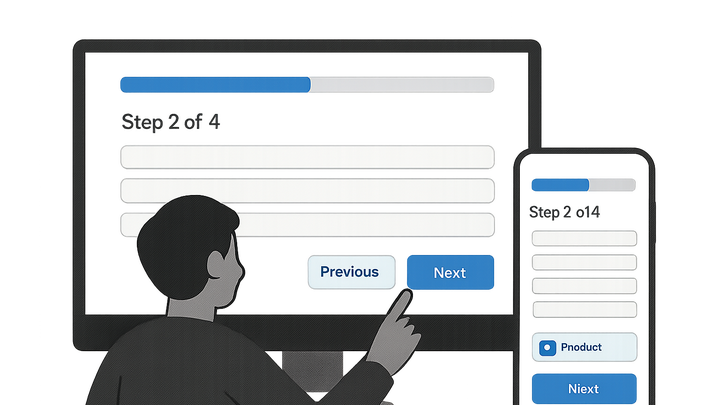Published on 2025-06-29T19:09:40Z
What is a Multi-Step Form? Examples of Multi-Step Forms
Multi-step forms break a long questionnaire or data collection process into a series of shorter, more manageable steps. Each stage focuses on a specific set of fields, guiding users through the flow with ‘Next’ and ‘Back’ controls. This approach reduces cognitive load and increases perceived progress, which can lead to higher completion rates. In the context of Conversion Rate Optimization (CRO), User Experience (UX), and SEO, well-designed multi-step forms can boost engagement and data accuracy while meeting accessibility standards. However, poor implementation—such as too many steps or unclear progress indicators—can increase abandonment. Tools like Prevue.me provide actionable critiques across CRO, lead generation, SEO, UX, and accessibility to help teams refine their multi-step forms. By pinpointing friction points and offering targeted recommendations, Prevue.me empowers product and marketing teams to optimize form performance and maximize lead generation.
Multi-step forms
A Multi-Step Form divides a lengthy form into sequential steps to improve engagement, conversion rates, and data quality.
What Are Multi-Step Forms?
Multi-step forms split a lengthy input process into smaller, focused segments. This approach can increase user engagement but also introduce navigation complexity if not designed properly.
-
Definition and structure
Multi-step forms consist of sequential sections or pages, each collecting a subset of information. They often include navigation controls like ‘Next’ and ‘Back’ buttons.
-
Single-step vs multi-step
Unlike single-page forms where all fields appear at once, multi-step forms present questions in stages. This can reduce overwhelm but may frustrate users if steps are unclear.
Benefits of Multi-Step Forms
Examine the advantages that multi-step forms offer in terms of engagement, conversions, and data accuracy, and why these benefits matter for CRO and UX.
-
Improved user engagement
Breaking a form into smaller steps helps maintain user focus and reduces perceived difficulty.
- Reduced cognitive load:
Presenting fewer fields at a time prevents users from feeling overwhelmed and improves completion rates.
- Clear progress feedback:
Visual indicators like progress bars show users how far they’ve come, boosting motivation to continue.
- Reduced cognitive load:
-
Higher conversion rates
Studies show that multi-step forms can lift conversion by making processes feel more approachable and interactive.
-
Enhanced data quality
Segmenting questions allows for conditional logic and targeted follow-up, leading to more accurate and relevant data collection.
Common Challenges and Pitfalls
Identify common issues that can undermine the effectiveness of multi-step forms and how to avoid them.
-
Overcomplication and too many steps
Excessive steps can frustrate users and lead to abandonment. Keep the number of steps to a minimum.
-
Lack of progress indicators
Without clear indicators, users may not know how many steps remain, increasing drop-off.
-
Mobile usability issues
Poorly optimized multi-step forms on mobile can suffer from navigation and input challenges, hurting completion.
Best Practices for Designing Multi-Step Forms
Actionable tips to design effective multi-step forms that balance usability, accessibility, and conversion goals.
-
Use clear progress indicators
Implement visual cues that show completion status and remaining steps.
- Progress bar:
A visual bar reflecting percentage completed provides an at-a-glance status.
- Step numbers:
Label each step numerically (e.g., ‘Step 2 of 5’) so users know their position.
- Progress bar:
-
Keep each step focused
Limit fields per step to a logical group, avoiding mixed or unrelated questions that can confuse users.
-
Optimize for mobile
Ensure touch-friendly elements, appropriate font sizes, and responsive layouts to facilitate mobile completion.
-
Provide save and resume options
Allow users to save progress and return later, reducing the risk of data loss and abandonment.
Example: Auditing Multi-Step Forms with Prevue.me
How prevue.me can be used to analyze and optimize multi-step forms for CRO, UX, accessibility, and SEO.
-
Actionable cro critiques
prevue.me identifies friction points in form flow and suggests layout and copy adjustments to improve conversion.
-
Ux and accessibility insights
The platform evaluates form interactions, keyboard navigation, and ARIA roles to ensure an inclusive experience.
-
Lead generation and seo recommendations
By reviewing form placement, load performance, and metadata, prevue.me helps boost lead capture and search visibility.
